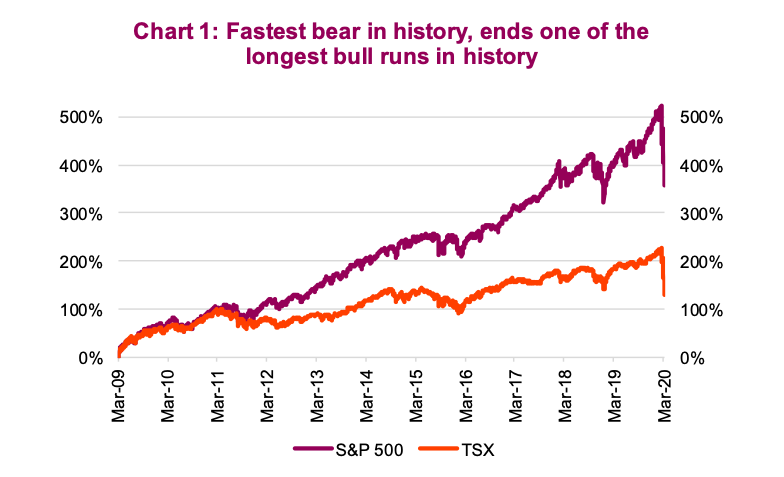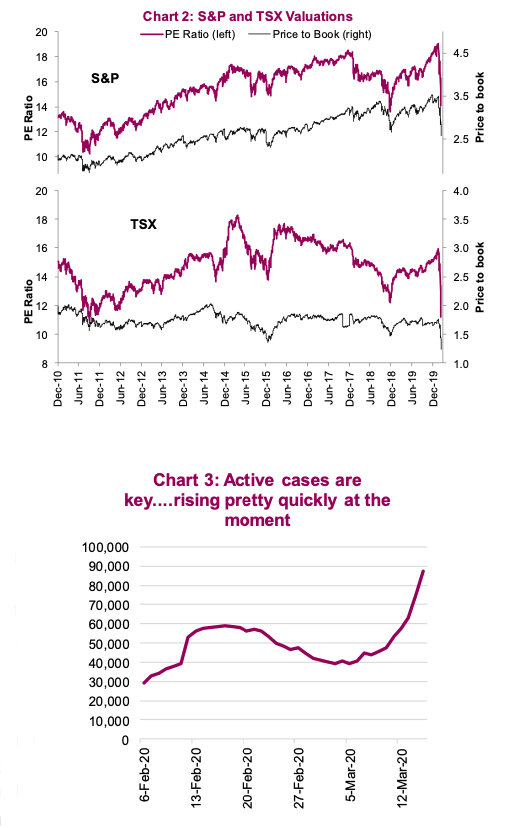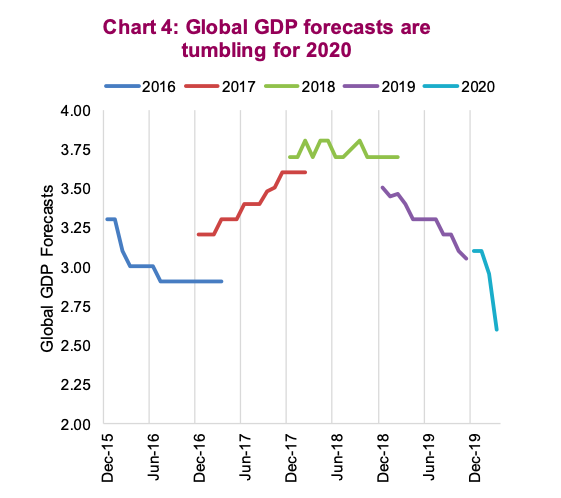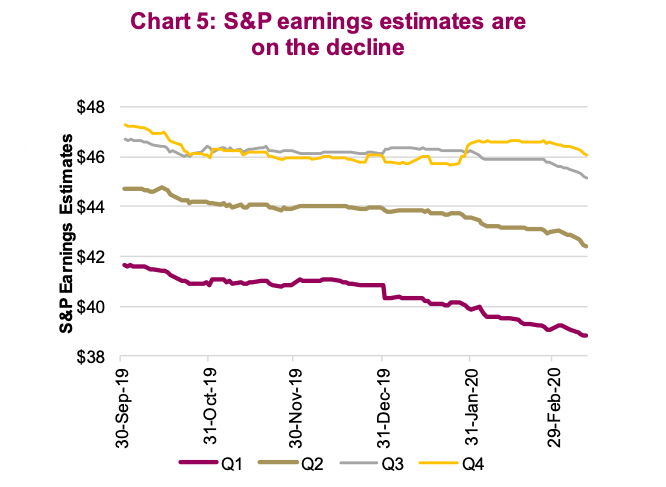The fastest stock market correction on record has been replaced by the fastest bear market on record as many major equity markets breached the -20% decline threshold this past week.
It was just over three weeks ago that the North American markets were at all-time highs.
On March 12, the TSX was down 12.3% and the S&P by 9.5%, the U.S. index’s biggest single-day loss since 1987.
If it’s any consolation, that faithful day in October 1987 saw the market drop over 20% in a single day.
Still, the speed of this stock market decline has tested the metal of just about every investor.
The bull market that started in March 2009 has now ended. For years folks have warned that the bull would end because of issues like lackluster earnings or sales growth, or tepid economic growth, or excessive central bank meddling, or even some big policy mistakes by governments – none of those did it. Instead it was a virus.
A virus that has created so much uncertainty and fear that investors have rushed to hit the sell button, only slowed down by regular handwashing and trips to buy toilet paper (a priority that still confuses me).
While this has been a very violent sell off, and we do not know if the bottom is near, let’s not forget the U.S. equity market rose over 31% in 2019. In fact, the S&P 500 was still higher heading into Monday (March 16) than it was at the start of 2019. The TSX is less encouraging, or more encouraging depending on how you look at things. The TSX was about 14,000 at the start of 2019 and is now 12,600. It’s sobering to see that the TSX is now flat over the past five years (including dividends).

The market is attempting to quantify a pile of unknowns. How will the virus pandemic play out in other countries such as the U.S. and Canada?
With more and more people working from home, cancelling travel and other plans, and stocking up on toilet paper, how much will economic growth contract? It is safe to say we are looking at growth dissipating and potentially contracting for a period.
Will this prove transitory or prolonged?
How will company operations and earnings be impacted?
There are some potential winners such as couriers, cleaning products, companies offering connectivity platforms and, of course, streaming services like Netflix, where binge watching is likely to rise. The losers far surpass the winners, however, so we would expect a material earnings contraction in the coming quarters.
Unknowns and uncertainties have already transitioned into share prices with valuations reaching very depressed levels in some pockets. The Canadian banks are trading at 7.6x earnings. If you agree the earnings may be at risk, how about a dividend yield of 5.8%? The S&P 500, which was trading over 19x earnings in mid- February, is now trading at 14x. Again, if you don’t buy the earnings as they are more uncertain, the price-to-book for the S&P is now 2.7x (Chart 2).

Virus
There is no shortage of anecdotal information floating around on the COVID-19 pandemic. While it could very well be the most challenging health event in decades, the hysteria continues to escalate. Lessons continue to be learned on how to deal with this pandemic and action appears to be taken at an increasingly rapid pace. Testing is becoming more widespread, sporting events cancelled, offices are sparsely populated as social distancing becomes the norm.
It is very difficult to even guess the various scenarios that could eventuate. China ignored the problem for months then embarked on highly aggressive measures. Now, active cases are on the decline there. The virus was clearly spreading in Italy before being detected and aggressive measures implemented later. In contrast, Korea embarked on strong measures very quickly and is starting to see active cases plateau. Taiwan has so far largely avoided the virus, utilizing isolation and location tracking via cell phone to see who an infected person may have contacted.
It’s extremely difficult to tell how widespread the virus is in the U.S. given relatively limited access to testing. Other countries, such as Canada, could very well be ahead of the curve with protocols developed during SARS. Our geographic distance from the epicenter could also work to our advantage. Still, it is anyone’s guess.
The market will likely get over the virus long before we as individuals do. For instance, given the market drop over the past three weeks with all the news of virus numbers, deaths and cancelled sporting events, among other developments, it may even now be pricing in some pretty dire news. If the news comes in worse, market goes down; if better, market goes up.
We continue to be keenly focused on the trajectory of worldwide active cases, which continue to rise (chart 3 above). The slope is key – a steepening is bad and a flattening is good. Given 11K net new active cases on March 14 and 12k on the 15th, this is not encouraging. But the daily information is noisy given batches of testing.
Economics & earnings
It will not surprise anyone when the economic data begins to soften around the world in the coming months. The impact on behavior is already starting to show up in the survey data, and the hard economic data will follow. Chart 4 is the consensus forecast for global GDP. We are accustomed to seeing these forecasts revised lower as the year progresses, but the 2020 forecast is falling very fast. There may be some reprieve from inventory stockpiling, but this will be a minor positive. We are likely looking at negative GDP growth for many nations.

Employment data will take a hit too in the form of rising unemployment. This could start to cause other economic dominos to start falling and turn a temporary disruption into a full-blown recession. Or, it won’t.
One positive aspect is that policy has certainly been supportive and continues to be so. After the big drop on March 12, a slew of central banks and governments announced both easing and fiscal stimulus plans. On March 13, the Bank of Canada cut the overnight lending rate by half a percentage point to 75 basis points (bps). This is on top of the 50bps cut last week. The Fed acted again over the weekend cutting the Fed Funds rate from 1.25 to 0.25 (or effectively zero as this is the upper band) and $700B of QE. Not sure if this is QE4 or 5, it’s confusing. These efforts will soften the economic blow and help markets operate.

Earnings estimates have started to come down and we would expect this to accelerate (Chart 5). Often, analysts don’t change estimates on the fly and will wait for the Q1 earnings season before adjusting. This will cause a sizeable drop in estimates during the month of April.
Portfolio implications
We would like to believe the worse of the equity market drop is over, but nobody knows for certain (markets look to be opening down almost 10% this morning). There have been more capitulation signals this past week including a VIX spike to over 70 and the percentage of investors that are now bearish is over 50%. This is encouraging. However, the path forward is full of uncertainties, from the trajectory of active COVID-19 cases, how much economy growth is curtailed and the subsequent impact on company earnings.
After a 25% decline, perhaps much of the bad news is priced in. But then again , this market has punished anyone who previously thought it was time to buy. The one day drop on March 12 – representing a 30+ year record – bodes well for future returns, as do bond yields picking back up. Time will tell.
Source: All charts are sourced to Bloomberg L.P. and Richardson GMP unless otherwise stated.
Twitter: @ConnectedWealth
Any opinions expressed herein are solely those of the authors, and do not in any way represent the views or opinions of any other person or entity.








